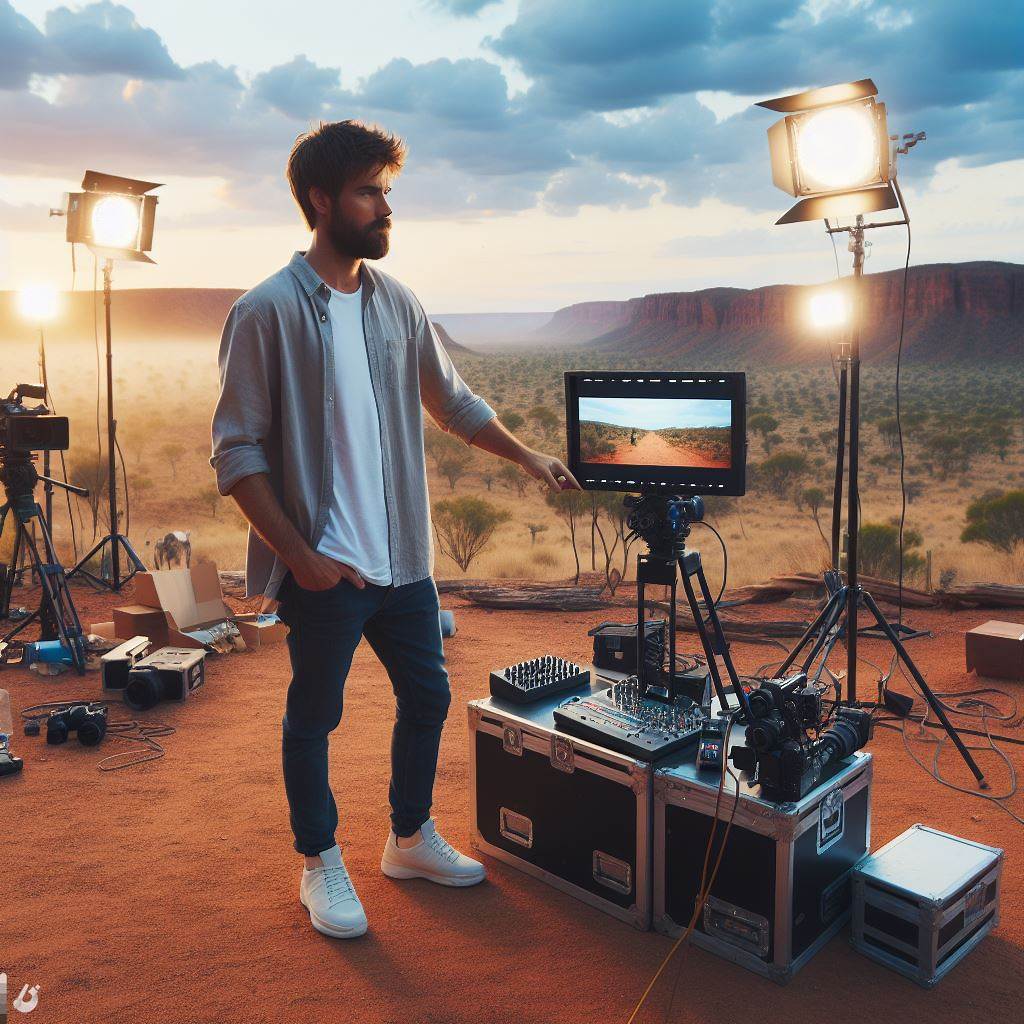Introduction
Music video directing is a dynamic field that requires creativity, technical expertise, and strong communication skills.
In this section, we will provide an overview of music video directing, highlighting the key aspects involved.
Additionally, we will stress the importance of learning from experienced professionals in order to enhance one’s directing abilities.
Music video directing involves the conceptualization, planning, and execution of visual narratives that complement and enhance musical compositions.
It requires a deep understanding of the song’s message and the artist’s vision.
By melding artistic expression with technical proficiency, a director can create a compelling visual representation of the music.
Learning from experienced professionals is crucial in honing one’s directing skills.
Their guidance can provide invaluable insights into various aspects of the craft, such as shot composition, storytelling techniques, and production logistics.
Collaborating with seasoned professionals allows aspiring directors to witness firsthand the decision-making processes and creative problem-solving required in the industry.
Furthermore, experienced directors can offer practical advice on navigating the dynamic landscape of music video production.
Their mentorship can help newcomers navigate challenges, such as working with limited budgets or tight schedules.
Additionally, exposure to the experiences of successful directors can inspire and motivate aspiring directors to push the boundaries of their creativity.
In review, music video directing is a multifaceted discipline that requires both artistic flair and technical expertise.
Learning from experienced professionals can significantly enhance one’s directing abilities and open doors to exciting opportunities in the industry.
By gaining insights and knowledge from those who have already succeeded, aspiring directors can position themselves for success in this competitive field.
Role of a Music Video Director
A music video director plays a crucial role in bringing an artist’s vision to life. They are responsible for overseeing every aspect of the production, ensuring that the final product aligns with the artist’s creative vision. Here are some key aspects of their role:
Definition and responsibilities
- The music video director is the person in charge of directing and managing the overall production.
- They work closely with the artist to understand their vision and translate it into a visual story.
- They are responsible for developing a concept that aligns with the song and resonates with the audience.
- The director handles all logistical aspects, such as scouting locations, hiring crew members, and managing the budget.
- During filming, they direct the actors and ensure that the shots capture the desired emotions and atmosphere.
- Post-production responsibilities include overseeing editing, color grading, and visual effects to enhance the final product.
Creative vision and storytelling
- A music video director needs to have a strong creative vision that complements the artist’s music.
- They must understand the song’s lyrics, tempo, and mood to create visuals that enhance the overall experience.
- Through visual storytelling, the director brings the song to life, evoking emotions and engaging the audience.
- They use various techniques such as camera angles, lighting, and choreography to enhance the narrative.
- The director ensures that the visual elements connect with the song’s message and engage the viewers throughout the video.
Collaboration with artists and production team
- Collaboration is essential between the music video director, artist, and production team.
- The director works closely with the artist to understand their musical style, personality, and desired themes.
- They brainstorm ideas together, combining the artist’s input with their own creative expertise.
- The director collaborates with the production team to bring their vision to life, ensuring smooth execution.
- They communicate their vision to the cinematographer, choreographer, and other crew members to achieve the desired outcome.
- Throughout the process, the director maintains open communication, fostering a positive and collaborative environment.
In fact, the role of a music video director is multifaceted, involving creative vision, storytelling, and collaboration. They are responsible for overseeing all aspects of production, from concept development to post-production.
Through their understanding of the artist’s vision and the song’s message, they create visuals that engage and resonate with the audience.
The success of a music video relies heavily on the director’s ability to bring together the artist’s vision, the production team’s expertise, and their own creative flair.
Tips from Aussie Music Video Directors
First-hand experiences and insights
As music video directing requires a deep understanding of the song, Aussie directors have shared some invaluable tips based on their experiences. These insights can assist aspiring directors in creating impactful and visually stunning music videos.
Emphasizing the message or narrative
An important aspect highlighted by Aussie music video directors is the need to emphasize the message or narrative behind the song. Understanding the core meaning and emotion conveyed by the lyrics enables directors to align their visuals accordingly.
By effectively translating the song’s message, directors can create a strong connection between the music and the visual representation.
Balancing artistic creativity and commercial appeal
In addition to conveying the message, directors must strike a balance between artistic creativity and commercial appeal. While visually striking videos may be admired by critics, they should also resonate with a wider audience.
Directors must consider the target audience and incorporate elements that engage and captivate viewers while staying true to their artistic vision.
Utilizing innovative cinematography techniques
Aussie music video directors also emphasize the importance of utilizing innovative cinematography techniques. Experimenting with unique shots and angles can add depth and visual interest to the video.
Directors should not be afraid to push boundaries and explore new ways to capture and present the artists and their music.
Selecting the right locations or sets
Another crucial aspect emphasized by Aussie directors is the selection of the right locations or sets. Scouting and choosing the perfect environment that complements the song’s mood or narrative can greatly enhance the overall visual impact.
Whether it’s natural landscapes, urban settings, or custom-built sets, the location plays a significant role in shaping the video’s aesthetic and atmosphere.
Building a strong connection with the artists
Lastly, building a strong connection with the artists is key to successfully translating their vision into a music video. Directors should establish a collaborative relationship and understand the artists’ preferences and aspirations.
By fostering a strong bond, directors can effectively bring out the best in the artists and create a visual representation that aligns with their artistic intent.
In general, Aussie music video directors provide invaluable tips based on their first-hand experiences and insights.
Emphasizing the message, balancing artistic creativity and commercial appeal, utilizing innovative cinematography techniques, selecting the right locations or sets, and building a strong connection with the artists are among the key aspects they highlight.
By following these tips, aspiring music video directors can enhance their storytelling abilities and create visually captivating and impactful videos.
Read: The Future of Directing in Australian Cinema
Case Studies of Successful Aussie Music Videos
Examples showcasing effective directing techniques
Music videos play a crucial role in amplifying the impact and reach of a song. With the right direction, they can become powerful visual representations that leave a lasting impression on viewers.
Australia has produced several music videos that exemplify exceptional directing techniques, weaving narratives, visually stunning cinematography, and unique concepts to captivate audiences. Let’s delve into some captivating examples:
Analysis of narrative-driven music videos
“Somebody That I Used to Know” by Gotye ft. Kimbra is a prime example of a narrative-driven music video. Directed by Natasha Pincus, it tells the story of a couple unraveling their troubled relationship through the concept of body paint.
The clever use of stop-motion animation adds depth and emotion to the narrative. Pincus successfully translates the song’s lyrics into visual storytelling, creating a thought-provoking and memorable experience.
Another notable narrative-driven music video is “Chandelier” by Sia, directed by Daniel Askill and Sia herself. The video features Maddie Ziegler’s captivating performance, portraying a young girl struggling with inner demons.
Askill’s direction effectively captures the raw vulnerability of Sia’s lyrics, combining powerful choreography and intense visual storytelling to create an emotionally charged experience.
Visually stunning cinematography
DIRECTOR X’s music video for Kendrick Lamar’s “Humble” showcases visually stunning cinematography. With striking contrasts and strong visual symbolism, the video keeps viewers engaged from start to finish.
The use of bold colors and captivating camera movements adds a layer of visual complexity that enhances the song’s powerful message.
Your Personalized Career Strategy
Unlock your potential with tailored career consulting. Get clear, actionable steps designed for your success. Start now!
Get StartedAnother visually impressive music video is “Cherry Wine” by Hozier, directed by Dearbhla Walsh. Shot entirely in one take, the video takes viewers on an emotional journey through the perspective of an abused woman.
The seamless camera movements and choreography contribute to the video’s impact, highlighting the importance of cinematography in storytelling.
Examining unique concepts and storytelling approaches
Flume’s “Some Minds” music video, directed by Clemens Habicht, stands out for its unique concept and storytelling approach.
The video showcases a collaboration between the music producer Flume and a contemporary dance group, combining intricate choreography with mesmerizing visual effects.
The creative use of mirrors and vibrant lighting adds a surreal element to the video, making it visually captivating.
The music video for Tame Impala’s “The Less I Know The Better,” directed by Canada, also employs a unique concept.
Through a mix of live-action and animated elements, the video tells the story of a love triangle involving a basketball player, a cheerleader, and a gorilla.
The visually dynamic animation and unexpected narrative twists elevate the video, delivering a memorable viewing experience.
These case studies of successful Aussie music videos highlight the power of effective directing techniques.
By analyzing narrative-driven videos, exploring visually stunning cinematography, and examining unique concepts, aspiring music video directors can learn valuable lessons and enhance their own storytelling skills.
With creativity and an understanding of the medium, music videos can become more than just accompaniments to songs – they can become transformative visual experiences that resonate with viewers.
Read: Essentials of TV Directing in Australia

Delve into the Subject: Digital Art Trends in Australian Media
Discover More: Day in the Life of an Aussie Film Director
Challenges and Solutions for Music Video Directors
Music video directing is a challenging task that requires immense creativity, resourcefulness, and exceptional organizational skills. As an Aussie music video director, you are likely to face numerous challenges along the way.
This section will explore some common obstacles faced by music video directors and the solutions to overcome them.
Budget constraints and resource management
One of the most significant challenges for music video directors is working within budget constraints.
Music videos often require expensive equipment, locations, props, and professional talent, which can quickly exhaust the available funds.
To tackle this challenge, directors need to find creative ways to maximize limited resources.
Instead of relying solely on costly equipment, they can explore alternative options such as borrowing or renting equipment from local film schools or production houses.
Additionally, they can collaborate with their network of industry professionals who may be willing to contribute their expertise or equipment at reduced rates or even for free.
Dealing with time restrictions and deadlines
Another challenge frequently faced by music video directors is the pressure of time restrictions and deadlines.
Music videos often have tight schedules due to the requirements of the artists, record labels, or other stakeholders.
To navigate this challenge, efficient planning and organization techniques are crucial.
Directors should establish a detailed production schedule that outlines specific tasks with allocated timelines.
This helps ensure that all aspects, from pre-production to post-production, are completed in a timely manner.
Furthermore, having a capable production team who understands and respects deadlines is essential for meeting time restrictions.
Maintaining a balance between artistic vision and client demands
Directors are often caught in the delicate balance between their artistic vision and the demands of their clients, such as artists or record labels.
While it is essential to maintain creative control, it is equally vital to meet the expectations of the clients.
Effective communication and negotiation strategies can help find a common ground.
Directors should establish open and transparent channels of communication with their clients from the very beginning.
This ensures that the visions and expectations are aligned.
Regular meetings and feedback sessions throughout the production process allow for adjustments and revisions without compromising the artistic integrity of the project.
Moreover, developing strong negotiation skills is crucial in finding compromises and solutions that satisfy both the director’s artistic vision and the client’s demands.
Generally, music video directing comes with its fair share of challenges.
Budget constraints and resource management, time restrictions and deadlines, and balancing artistic vision with client demands are among the most prevalent obstacles faced by directors.
Aussie music video directors navigate challenges by maximizing resources, using efficient planning, and fostering effective communication and negotiation, creating visually stunning videos.
Read: Cultural Diversity in Aussie Media
Learn More: Top Journalism Schools in Australia
Skillsets and Resources for Aspiring Music Video Directors
As an aspiring music video director, it is important to develop a set of skills and gather the necessary resources to excel in this field.
In this section, we will explore the recommended technical skills and knowledge for music video directors, as well as the educational opportunities and courses available to aspiring directors.
Recommended technical skills and knowledge
Understanding camera equipment and shooting techniques
To create visually stunning music videos, directors must have a solid understanding of different camera equipment and shooting techniques. This includes knowledge of various camera models, lenses, lighting setups, and composition techniques.
By mastering these technical aspects, directors can effectively bring their artistic vision to life.
Basic knowledge of editing and post-production processes
While capturing captivating footage is essential, the magic truly happens during the editing and post-production stages. Directors should have a basic understanding of editing software and the overall post-production process.
This includes knowing how to sync music with visuals, utilize effects and transitions, and ensure the final product meets the desired aesthetic and storytelling requirements.
Stand Out with a Resume That Gets Results
Your career is worth more than a generic template. Let us craft a resume and cover letter that showcase your unique strengths and help you secure that dream job.
Get HiredEducational opportunities and courses
Film schools and workshops in Australia
Australia boasts several reputable film schools and workshops that offer courses specifically tailored to aspiring directors. These institutions provide hands-on training, theoretical knowledge, and networking opportunities.
Some notable film schools in Australia include the Australian Film Television and Radio School (AFTRS), Sydney Film School, and Victorian College of the Arts.
Online resources and tutorials
For those unable to attend physical institutions, online resources and tutorials can provide valuable guidance and education. Numerous websites offer free or paid video tutorials, industry insights, and tips from experienced professionals.
Websites like Film Riot, No Film School, and Music Video 101 are great starting points for aspiring directors looking to expand their knowledge and skills.
Ultimately, aspiring music video directors should prioritize the development of technical skills and knowledge in camera equipment, shooting techniques, editing, and post-production processes.
Additionally, exploring educational opportunities such as film schools and workshops in Australia, or utilizing online resources and tutorials, can further enhance their understanding and proficiency in music video directing.
By continuously learning and honing their craft, aspiring directors can increase their chances of success in this dynamic and visually-driven industry.
Read: Freelance Journalism in Australia
Conclusion
To synthesize our discussion, let’s succinctly revisit the key points explored throughout this discourse, reinforcing the fundamental insights gleaned from our examination of the subject matter.
Extending a heartfelt encouragement to aspiring music video directors, particularly those eager to enhance their craft, we spotlight the wealth of knowledge encapsulated in the tips and experiences shared by Australian directors.
Learning from their unique perspectives and diverse journeys can serve as an invaluable compass for those navigating the dynamic landscape of music video production.
Emphasizing the essence of continuous improvement, we underscore the pivotal role that regular practice and refinement play in honing directing skills.
The journey toward mastery requires dedication to the craft, a commitment to learning from both successes and setbacks, and a willingness to evolve with the ever-changing nuances of the creative process.
This conclusion bridges the gap, inviting aspiring music video directors to absorb shared wisdom, engage actively in practice, fortify foundations, and propel artistic journeys forward.




